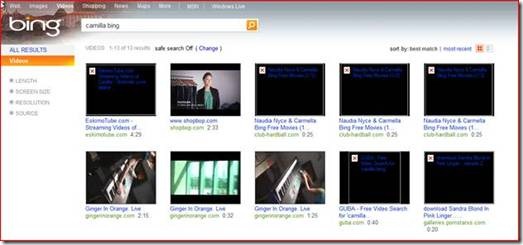Bing Content Filtering
We have received feedback from a number of customers and web filtering vendors about content filtering and enforcement concerns with Bing. Microsoft is committed to providing you with industry leading content filtering and enforcement capabilities and has taken action to address these recent concerns. Our goal is for you, and the firewall and parental control partners you rely on, to fully leverage Bing safe search (or to apply your own custom filtering logic) to meet your needs for web content filtering.
Today, one popular method that content filtering software use is to insert a parameter into the outbound query string to over ride any client side setting and enforce content control. This is a method supported by all major search engines including Bing; however our capability was not clearly publicized and was also not consistently implemented by content control software vendors. The result was that some customers concerned about search safety opted to completely block Bing in their environments.
In addition to safe search enforcement, customers and partners also need a variety of means to filter or block objectionable images and video. Microsoft worked on improving our capabilities in this area based on customer and partner feedback and today, Bing content filtering and enforcement capabilities match or exceed industry best practice. However, success with search safety also involves content filtering partner solutions and we are conducting outreach to these content control vendors, while continuing to improve our capabilities based on feedback.
Below is a summary of what we are doing to provide a safe search experience with Bing:
Bing Safe Search Setting and Enforcement
· The default safe search setting is set to “Moderate” which automatically blocks access to all explicit image and video content.
· The setting is maintained in a client side cookie and a user must proactively change their safe search settings from “Strict” or “Moderate” to “Off” in order to access explicit images or video. However, even if a user changes their setting, administrators can always override the users client side setting by appending the parameter “&adlt=strict” (case sensitive) to all queries to the bing.com domain. This will set the safe search setting to “Strict” and block all explicit content, including text results. An example of this is https://www.bing.com/videos/search?q=adulttermgoeshere &adlt=strict
Explicit Image and Video Domain and URL Based Content Blocking
· Image and video thumbnails (e.g. the static image thumbnails as well as the video thumbnails) have the source URL appended to the end of the thumbnail URL so that customer and web filter vendors have the information they needed to filter using their own logic/criteria.
· Bing returns all explicit images and videos from a specific domain. Customers can block either *.explicit.bing.net (assuming wildcards work with your solution) or the following four sub-domains to prevent bing.com from displaying images, videos or even thumbnails of content we suspect is explicit because of the nature of its source site or metadata. Images, videos and thumbnails for non-explicit content will still work.
· ts1.explicit.bing.net
· ts2.explicit.bing.net
· ts3.explicit.bing.net
· ts4.explicit.bing.net
With these capabilities, customers and web filtering vendors have all the tools needed to provide and enforce a safe search experience. Thank you to everyone who shared feedback with us on this matter which helped us to quickly develop a solution and get it into production.
FAQ
How does this compare with other search engines? Both Yahoo! and Google provide options similar to numbers 1 and 2 detailed above, however only Bing serves explicit images and videos from a specific domain. Many vendors will still choose to use the source information returned with explicit content, but serving explicit content from a specific domain allows customer and web filtering vendors the option to block only *explicit.bing.net, rather than having to manage a huge list of blocked domains or content. This option is only provided by Bing.
How does Bing indentify explicit content? We currently use several methods to detect material that may be explicit or pornographic, including: manual labeling, text classification, image classification and metadata associated with the page, etc... Our approach to this issue continues to evolve and our methods may change in the future if we determine that there are more effective and appropriate ways to detect this material.
What controls are there for parents? Because a user can change the safe search setting on the client, we recommend that parents who want to enforce safe search utilize content filtering software to ensure that content control is enforced.
What is the user experience with parental controls? Depending on the software, a page with explicit content will either be blocked outright or just the explicit thumbnails hosted on explicit.bing.net will be blocked. Filtering software with multiple layers of protection such as screening for blacklisted keywords or setting safe search to strict should block most pages with explicit terms or force safe search on. In that case where a page is returned it will look like the image below (may vary depending on the software):
